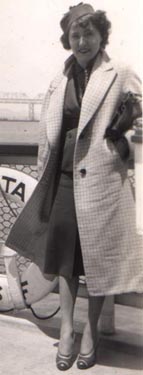Marguerite Roberts

Marguerite Roberts

Career Highlights
Marguerite Roberts had little preparation for a career as a screenwriter. Beyond high school, she had only a two-month secretarial course at a business college in Colorado. During the early 1920s, Roberts and her husband traveled around the Southwest United States selling imitation pearls. However, business dried up and left them marooned in El Centro, California. Roberts found work as a reporter for the local paper. Later, abandoning her marriage, Roberts moved to Los Angeles, where a sister of hers was living.
Roberts got a job as a secretary at Fox-Western, and later was promoted to script-reader. With a fellow script-reader, Roberts proposed her first screenplay. Later, Roberts worked under contract at Paramount, where she met her second husband, John Sanford. In 1939, Roberts signed the first of a string of contracts with Metro-Goldwyn-Mayer that would make her one of the most respected and highest paid screenwriters in Hollywood. She wrote screenplays for Katharine Hepburn, Clark Gable, Lana Turner, Elizabeth Taylor, Gregory Peck and Spencer Tracy. In 1941, Roberts co-wrote the Gable-Turner western Honky Tonk with Sanford.
In 1951, Roberts was called before the U. S. House Committee on Un-American Activities. She took the Fifth Amendment and declined to answer questions about whether she had been a member of the Communist party. This decision placed her on the film industry's Blacklist, making her unemployable. Sanford and Roberts traveled to England, where Roberts unsuccessfully attempted to find work as an expatriate. The couple returned to the United States, where they began ten years of anguishing internal exile, in which Roberts could not ply the profession that she loved.
Finally, in 1961, Roberts became one of the first blacklisted screenwriters to be offered a studio contract, when she accepted employment at Columbia. In 1969, Roberts wrote the screenplay for True Grit, which won John Wayne his only Oscar. Roberts retired from screenwriting in 1971.
Filmography
| 1933 | Sailor's Luck | |
| 1933 | Jimmy and Sally | |
| 1934 | Peck's Bad Boy | |
| 1935 | College Scandal | |
| 1935 | Men Without Names | |
| 1935 | The Last Outpost | |
| 1936 | Rose Bowl | |
| 1936 | Forgotten Faces | |
| 1936 | Florida Special | |
| 1936 | Hollywood Boulevard | |
| 1937 | Wild Money | (uncredited) |
| 1937 | Turn Off the Moon | |
| 1938 | Meet the Girls | |
| 1939 | They Shall Have Music | (uncredited) |
| 1940 | Escape | |
| 1941 | Ziegfeld Girl | |
| 1941 | Honky Tonk | |
| 1942 | Somewhere I'll Find You | |
| 1944 | Dragon Seed | |
| 1946 | Undercurrent | (uncredited) |
| 1947 | Desire Me | |
| 1947 | The Sea of Grass | |
| 1948 | If Winter Comes | |
| 1949 | The Bribe | |
| 1950 | Ambush | |
| 1951 | Soldiers Three | |
| 1952 | Ivanhoe | (credit restored) |
| 1953 | The Girl Who Had Everything | (uncredited) |
| 1962 | The Man Attraction | (uncredited) |
| 1962 | Diamond Head | |
| 1963 | Rampage | |
| 1965 | Love Has Many Faces | |
| 1968 | 5 Card Stud | |
| 1969 | True Grit | |
| 1970 | Norwood | |
| 1971 | Red Sky at Morning | |
| 1971 | Shoot Out |
Sources
The information on this page comes from the writings of John Sanford, an interview of Roberts by Tina Daniell, published in Tender Comrades, and an article by film historian Joseph McBride, "A Woman with True Grit," originally published in the Writers Guild Magazine, Written By, in November 1999. Prof. McBride's article is reprinted as the afterword of John Sanford's last book, A Palace of Silver. It is also reprinted in McBride's newly published Two Cheers for Hollywood: Joseph McBride on Movies, which includes a long essay on Sanford.
|
A Palace of Silver | Capra Press | 2003 | eBook |
Memoirs
Much of John Sanford's writing has been dedicated to describing his life with Maggie Roberts. In Maggie: A Love Story, Sanford covers the span of their relationship. We Have a Little Sister is something of a prequel, in which Sanford imaginatively reconstructs Maggie's life prior to their meeting.
|
Maggie: A Love Story | Barricade Books | 1993 | eBook |
|
We Have a Little Sister | Capra Press | 1995 | out of print |
Return to the John Sanford Homepage
Go to the John Sanford Biography Page
rev. 9/3/21